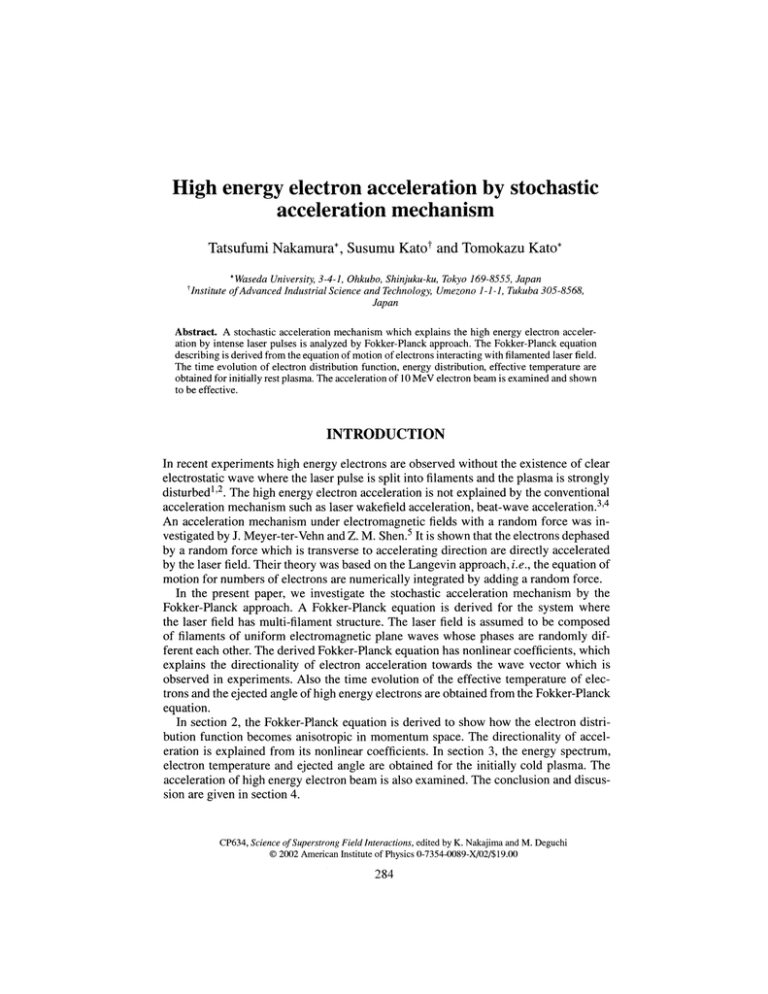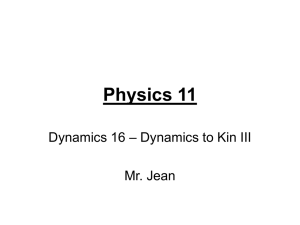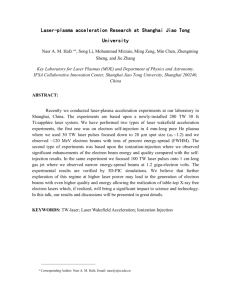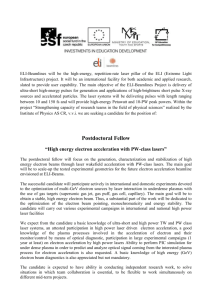High energy electron acceleration by stochastic acceleration mechanism Tatsufumi Nakamura*, Susumu Kato
advertisement

High energy electron acceleration by stochastic
acceleration mechanism
Tatsufumi Nakamura*, Susumu Katof and Tomokazu Kato*
*Waseda University, 3-4-1, Ohkubo, Shinjuku-ku, Tokyo 169-8555, Japan
^Institute of Advanced Industrial Science and Technology, Umezono 1-1-1, Tukuba 305-8568,
Japan
Abstract. A stochastic acceleration mechanism which explains the high energy electron acceleration by intense laser pulses is analyzed by Fokker-Planck approach. The Fokker-Planck equation
describing is derived from the equation of motion of electrons interacting with filamented laser field.
The time evolution of electron distribution function, energy distribution, effective temperature are
obtained for initially rest plasma. The acceleration of 10 MeV electron beam is examined and shown
to be effective.
INTRODUCTION
In recent experiments high energy electrons are observed without the existence of clear
electrostatic wave where the laser pulse is split into filaments and the plasma is strongly
disturbed1'2. The high energy electron acceleration is not explained by the conventional
acceleration mechanism such as laser wakefield acceleration, beat-wave acceleration.3'4
An acceleration mechanism under electromagnetic fields with a random force was investigated by J. Meyer-ter-Vehn and Z. M. Shen.5 It is shown that the electrons dephased
by a random force which is transverse to accelerating direction are directly accelerated
by the laser field. Their theory was based on the Langevin approach, i.e., the equation of
motion for numbers of electrons are numerically integrated by adding a random force.
In the present paper, we investigate the stochastic acceleration mechanism by the
Fokker-Planck approach. A Fokker-Planck equation is derived for the system where
the laser field has multi-filament structure. The laser field is assumed to be composed
of filaments of uniform electromagnetic plane waves whose phases are randomly different each other. The derived Fokker-Planck equation has nonlinear coefficients, which
explains the directionality of electron acceleration towards the wave vector which is
observed in experiments. Also the time evolution of the effective temperature of electrons and the ejected angle of high energy electrons are obtained from the Fokker-Planck
equation.
In section 2, the Fokker-Planck equation is derived to show how the electron distribution function becomes anisotropic in momentum space. The directionality of acceleration is explained from its nonlinear coefficients. In section 3, the energy spectrum,
electron temperature and ejected angle are obtained for the initially cold plasma. The
acceleration of high energy electron beam is also examined. The conclusion and discussion are given in section 4.
CP634, Science of Superstrong Field Interactions, edited by K. Nakajima and M. Deguchi
© 2002 American Institute of Physics 0-7354-0089-X/02/$ 19.00
284
(b)
(a)
surface of
4>i *-" constant phase'*
*2
k
<t>2
I
df
*3
FIGURE 1.
*i
<t>3
Schematic figure of the phase for (a) uniform laser field, (b) filamented laser field.
FOKKER-PLANCK EQUATION
In this paper we consider the situation where the laser field is divided into some regions
in a transverse plane such as multi-filament structure. The structure is observed in
the experiments of electron acceleration by intense strong laser fields, such that the
laser field becomes nonuniform, e.g., the laser pulse is split into filaments due to the
interaction between the laser field and the plasma. The illustration of the phase of the
laser field is drawn in Fig. 1. In the multi-filament structure the surface of a constant
phase is modified as Fig. l(b). For simplicity we assume d — 0, then the phase sharply
changes at the filament edge. The phase of the laser field in each region is different,
while it is uniform inside one region, i.e., the laser field is consist of sectionally divided
plane waves. Let us consider an electron with initial momentum UXQ, UZQ. The electron
motion in a filament is written as
ux =
uz =
a = j-uz,
X = cot- kz.
(1)
a
2a
(2)
(3)
(4)
where CO and k are the laser frequency and wave number of the electromagnetic field
which corresponds to the filament. And UXQ, uz& and %Q are the initial values of ux, uz,
and #, respectively, and a = eA/mc is the normalized vector potential, a is a constant of
motion. The electron leaves the region at t = t\ with ux = ux\ and uz — uz\ and enters an
adjacent region. Then the electron executes again the periodic motion with ux\ and uz\
as new initial values until it moves to a different region. Therefore the electron gained
Sux — ux\ — UXQ and Suz = uz\ — uz$ in moving through this region. The detail of this
gain is discussed in the next paragraph. Electron experiences different phases as it enters
the adjacent region with time step ic. The phase of the laser field in the different region
285
is assumed to be randomly different. This allows us to treat the electron motion as a
random process where 0 = sin# — sin(^o) is a random variable with — 2 < 0 < 2. The
equation of motion of an electron for n-th step is written in a same manner such as,
(5)
where an — y(ux^uz,n) — u^n. In the time scale of 7] > Tc, eqs. (5) and (6) are written
in differential forms as follows,
OUZ
•~A*~ T
~={—
i
•~
T
<9r] — ———
rca ~r;;——•
2rca
/o\
(w
The Fokker-Planck equation for the processes is obtained as6,
dfe
a2D (92fe
_ -
2
du
„ d fe
,
, d2 ft
— - — - — - — _ _
duza~
x
du2 a2
where /g denotes the electron distribution function. Here the stochastic variable </> is
assumed to be the Gaussian with < 0 >= 0 and < </>(f)0(V) >= Dd(t — t'} where
D <^ 1. From the first term in eq. (9) it is seen that the time evolution of fe is a normal
diffusion process in ux and estimated as < ux >~ a/Tc\/Z)f. The second and third terms
correspond to the drift and diffusion processes of fe in uz, which include a(ux,uz).
In both terms a(ux,uz) plays an important role since < uz > is roughly estimated as
< uz >~ (a/Tc^/Di)/a — < ux > /a. It is known that I/a is small unless ux ~ 0, and
I/a is proportional to wz for uz > 1 and I/a ~ 0 for wz < 0. Therefore the electron
distribution drifts and diffuses in the positive uz direction and not in negative direction.
The diffusion effect in uz is much larger than that in ux. These facts explain the strong
directionality of the acceleration towards uz.
ACCELERATION OF ELECTRONS
The time evolution of fe is obtained by numerically solving the Fokker-Planck equation,
which is plotted in Fig. 2. The initial conditions are the Maxwell distribution with
kgT = 5 keV, a = 3, D = 0.05, and Tc = 10. In uz direction, the electrons with large
uz are strongly accelerated only in positive direction. The distribution slowly diffuses in
ux. In Figs. 2 (b), (c), and (d) there are two peaks in the high energy tail, which means
that the high energy electrons will be observed in a direction which is slightly deviated
from the laser propagation direction. This is explained from the third term in eq. (9)
such that the electrons with small ux are slightly more accelerated than electrons with
ux — 0. The high energy electron beam tend to be collimated towards the direction of
the wave vector. The angle exponentially decreases in time7. The energy distributions at
286
I f
4
&
10
i:
'if
FIGURE 2. Profile of electron distribution in momentum space at (a) cot = 100, (b) cot — 1000, (c)
cot = 2000, and (d) cot - 3000.
10
ie1
62r
10-
'•
10
Electron kinetic energy (MeV)
FIGURE 3. Energy distribution of accelerated electrons whose initial energy is 5 keV at cot =
600(dashed line), 1800(solid line), and 3000(dotted line).
287
10
20
30
40
50
Electron kinetic energy (MeV)
FIGURE 4. Energy distribution of accelerated electrons whose initial energy is 5 keV (dotted line) and
10 MeV (solid line) at cot = 3000.
a\)t = 600,1800 and 3000 are plotted in Fig. 3. It is seen that the distribution is quasithermal distribution and its effective energy increases up to 2.8 MeV at co^t = 3000 while
the ponderomotive energy is 1 MeV. The acceleration of high energy electron beam is
also examined. The energy distribution of electrons which are propagating in z direction
with the average of 10 MeV and the thermal energy of 5 keV. The energy distribution at
cot — 3000 is plotted in Fig. 4. A large numbers of electrons are accelerated up to about
17 MeV. The profile of the high energy tail for 10 MeV beam is similar to the profile for
the rest plasma.
DISCUSSION AND CONCLUSION
Stochastic acceleration mechanism is analyzed by the Fokker-Planck approach. The time
evolution of the electron distribution function shows the directionality of the acceleration
which is the important feature of electron acceleration by the intense laser field. The
effective temperature roughly scales as T °c ft where j8 ~ 1, while 0.5 < j3 < 1 is
obtained by Langevin approach. The effective temperature becomes higher than the
temperature corresponding to the ponderomotive energy. A high energy electron beam
is effectively accelerated since the electrons have the feature suitable for stochastic
acceleration,/, e., pz > 1, and px <C pz.
In the experiment of Gahn et al. the laser pulse is 200 fs with 1.2 TW, correspondingly
a— 1.4, and the plasma density is n — 4 x 1020cm~3. The measured effective plasma
temperature is 2.2 MeV where the observed channel length is about 400 /im. Their
result is recovered in our theory by adjusting the time scale, namely y-y
in eq. (9). Since
ZT
the radius of the filament is approximately c/cop, ic is estimated as ic ~ C/((OPVX)(OQ
where vx ~ c\fu^ is me average velocity when an electron moves to an adjacent region.
C
288
From eq. (5) the average velocity is estimated as a\fD. Therefore Tc is estimated as
Tc c± CQQ/(o)pa\fD). The coefficient of the Fokker-Planck equation becomes ^§ ~
(a2Dcop/G)o)2/2. By setting the coefficient D = 0.07, the effective temperature at (Qtf =
3100 which corresponds to the channel length of 400/1 m is obtained as 2.2 MeV. In their
result of angular distribution of electrons, there exist two peaks which are at 9 = 0° and
9 ~ 5°. The result for the second peak might be explained by our theory. In our case,
the peak at 0 = 0 does not appear since the indirect acceleration mechanism such as
wakefield acceleration is not taken into account.
The model that the laser field is divided into regions with randomly different phase
is suitable for the understanding of the direct laser acceleration experiment1'2. It is
observed that the laser pulse propagating through underdense plasma split into the
filaments when its power well exceeds PC[PW] = 17(o)Q/0)p) which is a critical power
for self-focusing.8 Also the plasma becomes in a turbulent state when the laser intensity
is in relativistic regime. In those cases, the electron experiences the laser field with
different phase during the interaction, and the stochastic acceleration plays the important
role.
REFERENCE
1. Gahn, C., Tsakiris, G. D., Pukhov, A., Meyer-ter-Vehn, J., Pretzler, G., Thirolf, P., Habs, D., and
Witte, K. L., Phys. Rev. Lett. 83, 4772 (1999).
2. Koyama, K., Saito, N., and Tanimoto, M., Proceedings of the 10th International Congress on Plasma
Physics, Quebec city, Canada, October 2000, p. 464.
3. Tajima, T., and Dawson, J., Phys. Rev. Lett. 43, 267 (1979).
4. Sprangle, P., Esarey, E., and Ting, A., Phys. Rev. Lett. 64, 2011 (1990)
5. Meyer-ter-Vehn, J., and Sheng, Z. M., Phys. Plasmas, 6, 641 (1999).
6. Toda, M., Kubo, R., Saito, N., and Hashitsume, N., Statistical Physics I I : Nonequilibrium Statistical
Mechanics, Vol. 2, (Springer-Verlag New York, 1991), Chap. 1.
7. Nakamura, T., Kato, S., Tanimoto, M., and Kato, T, Phys. Plasmas, 9, 1801 (2002).
8. Wang, X., Krishnan, M., Saleh, N., Wang, H., and Umstadter, D., Phys. Rev. Lett. 84, 5324 (2000).
289


